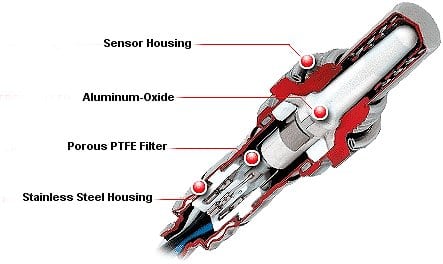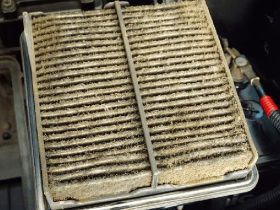Many vehicles still use standard O2 sensors rather than the more complex AFR. An in-depth look at how they operate may help you diagnose those common O2 sensor errors that are the most common engine diagnostic code given by the OBD-II system in your car’s computer.
How an O2 Sensor works
 The oxygen sensor reacts to oxygen (O2) molecules in the exhaust stream through a simple ionic buildup that creates a charge that can be read by the sensor and engine computer. The higher the charge, the more oxygen there is in the exhaust.
The oxygen sensor reacts to oxygen (O2) molecules in the exhaust stream through a simple ionic buildup that creates a charge that can be read by the sensor and engine computer. The higher the charge, the more oxygen there is in the exhaust.
This measurement is taken through the simple, but effective way an O2 sensor is designed. A simple metal case (usually aluminum or another conductive material) has a core of Zirconia at its center. Exhaust is sent through this core, which reacts to the oxygen present and creates an ionic charge. Most of this charge is passed off to the ambient air around the sensor, which usually has more oxygen in it than does the exhaust. Whatever ionic charge is left will be read by the sensor, indicating the amount of O2 in the exhaust stream.
The amount of voltage or draw (drain) being read in the sensor by the engine’s computer determines the approximate O2 amount in the exhaust, which can indicate whether a change in the fuel:air mixture is needed to improve efficiency.
The very simple build of the O2 sensor means it is not generally prone to failure in its components, but they often do fail due to outside influence. The circuitry or connections to them may fail, the electronics in the sensor itself could fail, or the sensor may become unreliable due to buildup or corrosion on the sensor’s surface. In most vehicles, O2 sensors are relatively easy to access and cheap to replace.
Why your car has oxygen sensors
Without these sensors, electronic fuel injection and emissions control would not be possible. O2 sensors help determine the current fuel:air mixture in the engine so the computer can control it in order to improve emissions and performance.
Higher amounts of oxygen in the exhaust stream means higher emissions at the tailpipe and indicates lower fuel economy due to an incorrect fuel:air mix.
Most vehicles have an oxygen sensor at the exhaust (usually on the manifold) and one at the catalytic converter. V-style engines will usually have two O2 sensors (one on each side) plus the one at the catalytic converter. The engine computer will refer to these as “Bank 1” or “Bank 2” sensors respectively.






